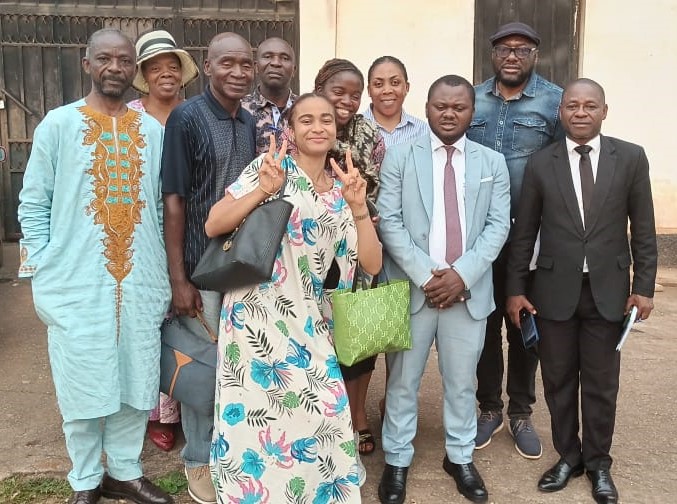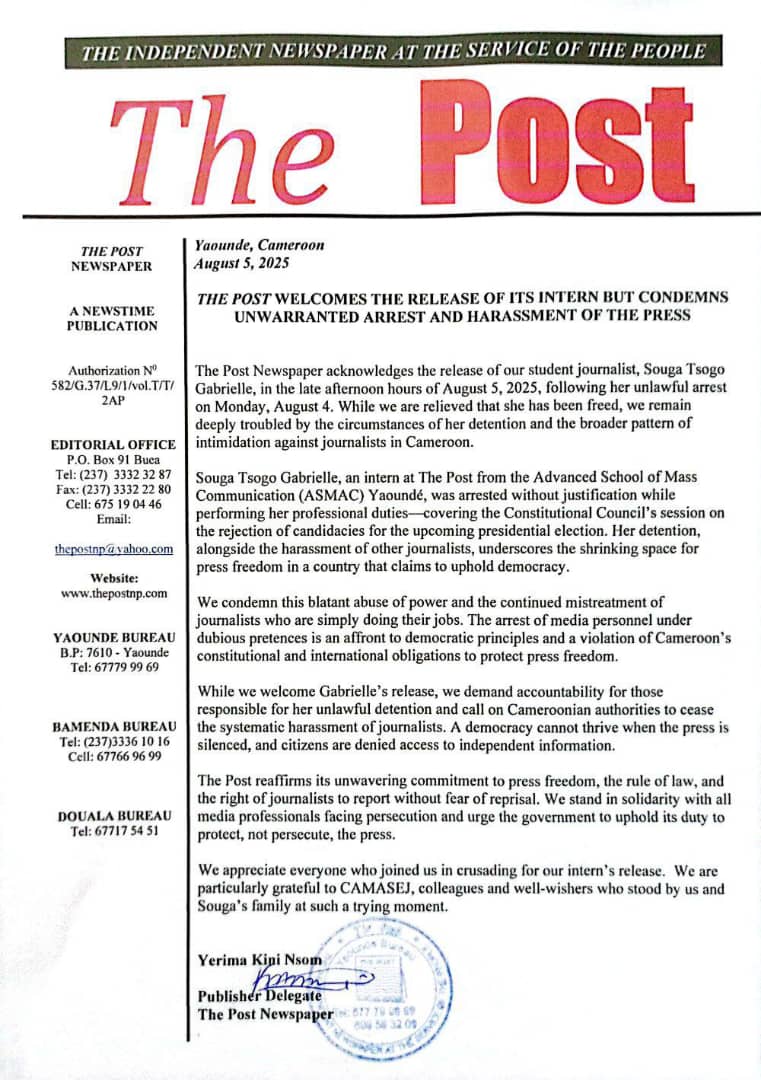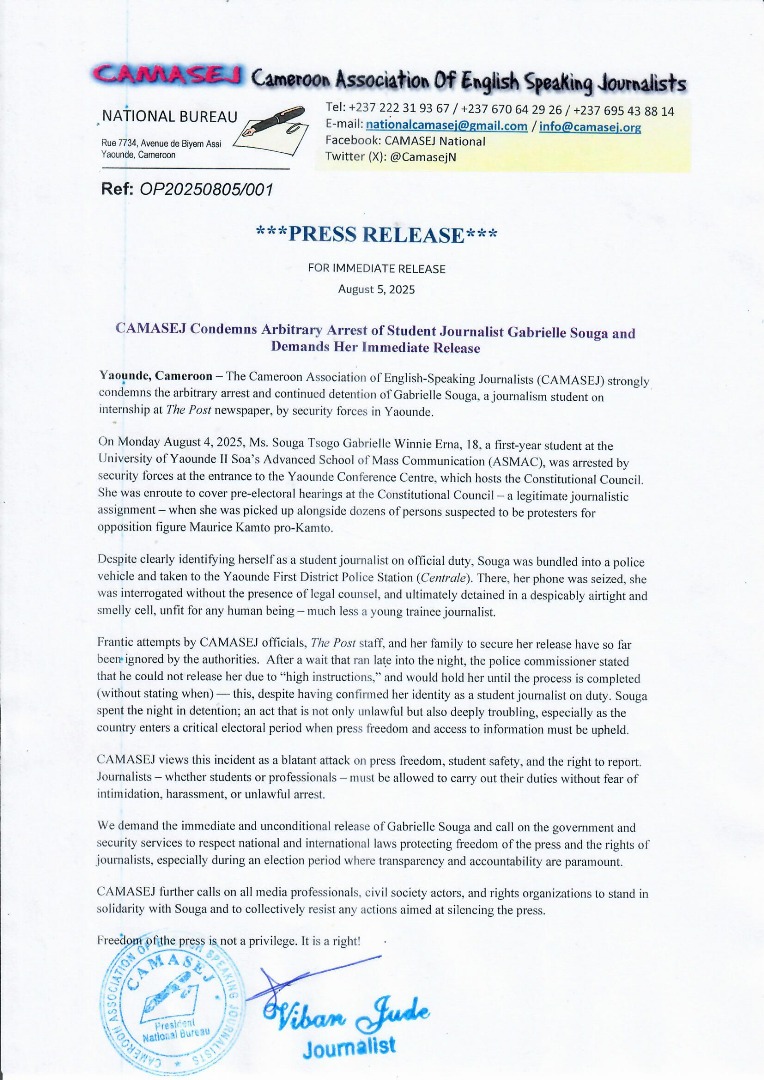By Nformi Sonde Kinsai & Etienne Mainimo Mengnjo
Gabrielle Tsogo Souga, a student journalist from the Advanced School of Mass Communication (ASMAC), has described her over 24-hour detention in police custody as a terrifying yet “moment of reflection” at the start of her career.

Souga was arrested on August 4 while accompanying his colleagues to cover a session of the Constitutional Council, which was reviewing rejected candidacies for the upcoming October 12 Presidential Election. She was with a senior colleague from The Post‘s Yaounde Bureau.
“Our Bureau Chief sent us there but we were stopped at the gate. We were then asked to contact our senior and the only crime I committed was taking out my phone to call her. She had gone ahead of us,” Souga said after her release. “Immediately, a police officer jumped, shouted, seized my phone, and pushed me into a waiting police van.”
At the police station, she said an officer insisted she was a supporter of opposition leader Prof. Maurice Kamto, who had come to protest. The officer demanded she produce a protest T-shirt that was in her keeping. She added that despite explaining she was a student journalist, no one believed her. “The only thing I did was just crying,” she said.

Passing a night at the detention center was scary as she described it as “unbelievable.” The crowded environment, with men and women held in the same room, made her uncomfortable. “I was detained in a poorly ventilated room with rats and insects all over,” she said
Other detainees, sensing she might be heading to prison, offered her advice: “Prison is a world of its own, and if you have a skill, it will be good. Don’t be afraid.”
She also noted that some detainees arrested with Kamto-branded T-shirts claimed they were unaware of the shirts’ political significance, having been told they would receive food and drinks for wearing them at the Conference Centre.
After oher release, Souga thanked her colleagues at The Post, the Cameroon Association of English-Speaking Journalists (CAMASEJ), her classmates, the National Human Rights Commission, and Diplomatic Missions as well as others for their efforts to secure her freedom.
The Post, CAMASEJ Condemn “Unlawful” Arrest
Following Souga’s arrest, her father and staff of The Post, along with leaders from CAMASEJ (both the national and Yaounde Chapter), rushed to the Yaounde First District Police Station. After spending a day there, they were told by Commissioner Dr. Thierry Medou that he could not guarantee Souga’s immediate release.
On the following day, The Post as well as the father presented documents proving Souga was an ASMAC student journalist, but the investigating officer said “it is only his hierarchy that has the final say.”

After waiting until 4 p.m. without any news, The Post and CAMASEJ issued statements condemning the arrest. The Post called it an “unlawful arrest and detention” and a “blatant act of intimidation and harassment against members of the press.” The newspaper added that the incident “constitutes a direct attack on press freedom in Cameroon.”
CAMASEJ detailed its unsuccessful attempts to secure Souga’s release, stating that police authorities “ignored” them. The association quoted the commissioner as saying he could not release her due to “high instructions” and would hold her until “the process is completed without stating when.” CAMASEJ called the incident a “blatant attack on press freedom, student safety, and the right to report.”

Both organisations demanded her immediate release. However, Souga was finally set free at around 6:15 p.m. on Tuesday, August 5, with no reason given for her detention.
A First-hand Look at the Central Police Station in Yaoundé
From a distance, the structure opposite the MTN Centre Regional headquarters appears unremarkable. But a closer look, both outside and in, reveals a facility in disrepair.
The entrance is cluttered with abandoned cars and hundreds of motorcycles that have seemingly been left for years. Inside, what should be a well-maintained building is instead an eyesore environment.
A foul odor from the toilets permeates the air, adding to the unhygienic conditions. One visitor, with a tightened nose, who came to renew her identity card, declined to comment on how people manage to endure the unpleasant environment.
Inside the building, the old, cramped offices make it difficult for officers to perform their daily duties. The conditions where arrested individuals are held are particularly grim. Both male and female detainees are kept in the same space, separated only by a flimsy partition.
Police officers are described as a mix of “very nice” individuals and others who are “extremely rude and arrogant” and will “insult you at any given or slightest opportunity.”
The station, just in front of the charge office counter is a sales point of where individuals come in to sell assorted food items from koki corn, puff-puff, groundnut sweet, garnished bread, and so. This saves visitors who must urgently buy something to provide to the detainee they want to meet.
In contrast to a message posted on the entrance into the cell prohibiting conversations by the detainees, the noise and rowdiness emanating from the detention unit defeats the instructions. On that same message, one could read: “no smoking, no alcohol, no belt…”
From the structure and working conditions, new and modern police stations need to be constructed not only good for the police officers and the detainees, but also to citizens visiting the facility for public services.
First published in The Post, Monday August 11, 2025 Edition No. 024500


